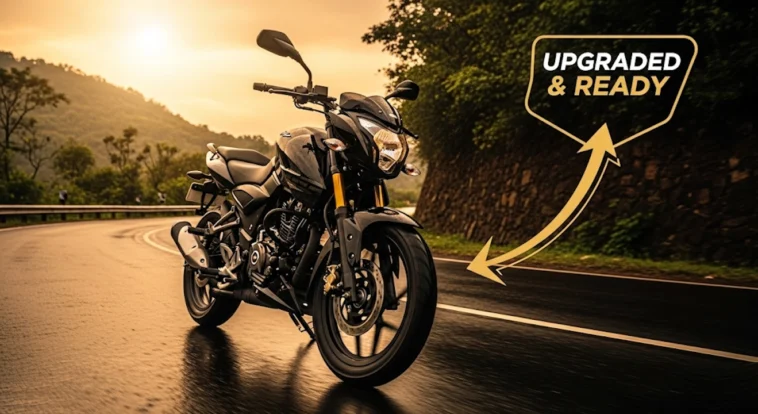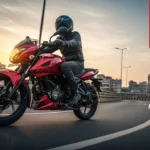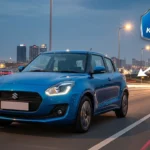Hello friends! In the fiery battle of 160cc street bikes, Bajaj has just armed its popular Pulsar N160 with a secret weapon to take on the undisputed king, the TVS Apache RTR 160 4V. The big news is the addition of premium upside-down (USD) front forks on the new N160, a massive upgrade usually seen on more expensive bikes!
This is a game-changer for the Pulsar, promising better handling and a more premium look. But with the Apache still ruling the spec sheets with its raw power, is this new, improved Pulsar N160 now the smartest buy for you? As your trusted auto buddy, let’s dive in and find out.
The New Pulsar N160: What’s the Big Deal?
The addition of USD forks is the biggest update, but the N160 has always had some killer features up its sleeve. Here’s what makes the current, updated model so special.
| Feature | What it Means for You |
| New USD Front Forks | Premium golden upside-down forks that give the bike a stunning look and, more importantly, make the handling sharper and more stable. |
| Dual-Channel ABS | A class-leading safety feature! It means both the front and rear wheels have anti-lock brakes, preventing skids during hard braking. This is a huge confidence booster. |
| Smooth Engine | A refined 164.8cc oil-cooled engine known for its smooth power delivery and strong mid-range pull. |
| Modern Features | Comes with a useful USB charging port and a gear position indicator on its semi-digital display. |
How Much Does the Updated N160 Cost?
Even with these premium upgrades, Bajaj has kept the Pulsar N160’s pricing incredibly competitive. It remains one of the best value-for-money bikes in its class. Here’s a look at the on-road prices.
| Bike Model | On-Road Price (Delhi, Approx.) |
| Bajaj Pulsar N160 (New) | ~₹1.52 Lakh |
| TVS Apache RTR 160 4V | ~₹1.55 Lakh |
| Hero Xtreme 160R 4V | ~₹1.58 Lakh |
(Note: These are estimated on-road prices for top variants with dual-channel ABS / dual discs.)
N160 vs. Apache 160 vs. Xtreme 160: The Big Fight!
This is the ultimate showdown of the 160cc class. A smooth operator vs. a track weapon vs. a nimble street dancer.
| Feature | Bajaj Pulsar N160 | TVS Apache RTR 160 4V | Hero Xtreme 160R 4V |
| Price (Ex-Showroom) | ~₹1.33 Lakh | ~₹1.38 Lakh | ~₹1.37 Lakh |
| Engine Power | 15.8 bhp | 17.3 bhp | 16.6 bhp |
| Safety | Dual-Channel ABS | Single-Channel ABS | Single-Channel ABS |
| Key Feature/Weakness | Feature: Best-in-class safety & smooth engine. Weakness: Not as powerful as the Apache. | Feature: Most powerful engine & ride modes. Weakness: Less comfortable for long rides. | Feature: Lightest & most agile. Weakness: Bouncy ride on bad roads. |
Our Verdict: Is the Pulsar N160 a ‘Buy’ or a ‘Pass’?
We’ve ridden all three bikes extensively. Here’s our simple, honest advice to help you choose the right one for your needs.
- For the “Smooth & Safe” Rider: The Pulsar N160 is a clear ‘BUY’ If your priority is a comfortable, smooth engine for city commuting and the best possible braking safety, the Pulsar N160 is the undisputed champion. We rode it in heavy traffic, and its engine is incredibly tractable. What really makes it a ‘paisa vasool’ deal is the confidence you get from its dual-channel ABS. With the new USD forks, it’s an even more stable and complete package.
- For the “Performance & Feature” Junkie: The TVS Apache RTR 160 4V is a ‘BUY’ If you’re young at heart and want the most powerful, feature-loaded bike that feels like it was born on a racetrack, the Apache is still the king. Its high-revving engine is an absolute joy, and features like ride modes and Bluetooth connectivity are the cherry on top. It’s the best choice for the pure enthusiast.
- For the “Agile City Slicker”: The Hero Xtreme 160R 4V is a ‘BUY’ The Xtreme is the lightest bike here, and it feels incredibly nimble and quick to change directions. If your daily commute involves slicing through chaotic city traffic, the Xtreme’s agility is a massive advantage. It’s a fantastic-looking bike that’s perfect for riders who prioritize quick handling above all else.
Common Questions Answered (FAQ)
What are USD forks, and why are they a big deal?
USD, or Upside-Down forks, are a more advanced type of front suspension. In simple terms, they are stronger and lighter than traditional forks, which improves the bike’s stability during braking and cornering, giving the rider more confidence.
Is the Pulsar N160’s dual-channel ABS really better than the Apache’s single-channel?
Yes, for overall safety, it is. Single-channel ABS only works on the front wheel. Dual-channel ABS works on both the front and rear wheels, preventing either wheel from locking up and skidding during emergency braking. It’s a significantly better safety feature.
Which of these bikes has the best mileage in the real world?
All three bikes are very fuel-efficient. In real-world city conditions, you can expect around 45 kmpl from the N160 and the Apache, while the lighter Xtreme might give you a slightly better 45-50 kmpl.
Which bike is the most comfortable for daily commuting with a pillion?
The Bajaj Pulsar N160 is arguably the most comfortable for both the rider and a pillion, thanks to its smooth engine, well-cushioned seat, and stable suspension.




